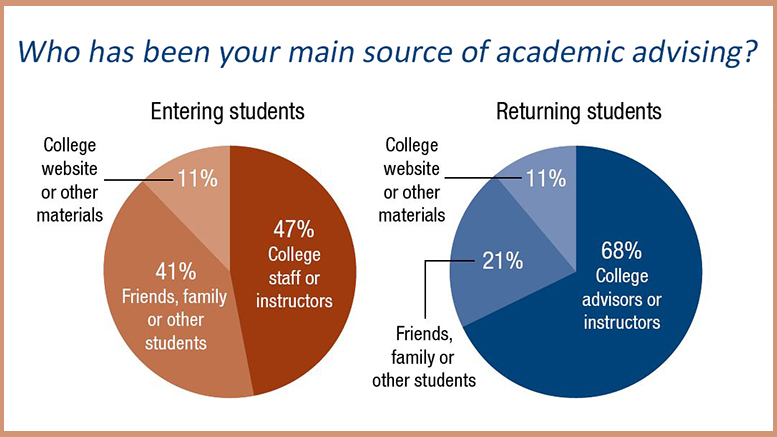Students who receive more advising are more engaged in college, according to a new report from the Center for Community College Student Engagement.
“If community colleges want to increase student engagement, one place to start is by examining the foundation of academic advising,” said Evelyn Waiwaiole, executive director of the center at the University of Texas at Austin.
Sixty-two percent of first-term students and 78 percent of returning students reported that they met with an advisor, but what matters most is the structure, content and intensity of advising, according to “Show Me the Way: The Power of Advising in Community Colleges.”
“Clearly, advising is not the same for all students,” Waiwaiole said. “But when advisors are spending more time talking with students about developing an academic plan, their career ambitions and opportunities for employment — this is where community colleges are seeing greater student engagement.”
Intense advising more effective
The report includes the following findings for returning students in the study:
- The initial advising session for almost half of students lasted 16 to 30 minutes, but students who met with an advisor for more than 30 minutes had higher engagement scores.
- Eighty-six percent of students reported that an advisor explained which classes they needed to take to reach their academic goals, but only 65 percent said an advisor helped them develop an academic plan.
- Almost two-thirds of students reported that their advisor did not discuss when their next advising session should be.
- Approximately two in five students reported that an advisor discussed regional employment opportunities with them based on their career interests.
- Half of the students interested in transferring to a four-year institution reported never using the college’s transfer advising services, yet students who did use those services reported higher engagement.
The study found student athletes generally had more advising experiences than other students. Sixty-seven percent of student athletes said they were required to see an advisor before registering for classes, compared to 54 percent of non-athletes. Nearly 70 percent of athletes reported meeting with the same advisor multiple times during a term, compared to 55 percent of non-athletes.
“A focused model such as this demonstrates that many colleges already have approaches to advising that lead to higher engagement,” Waiwaiole said. “It may be cost prohibitive to scale up a comprehensive advising model that currently is used for only a small group of students, but colleges can evaluate their processes for small-scale, in-depth advising and consider which aspects of the model might be used for all students.”
Guidance for transfer students
The report includes several examples of how community colleges are improving their advising processes.
Asheville-Buncombe Technical College in North Carolina, for example, established a Transfer Advising Center in fall 2016. All new students seeking to transfer are assigned an advisor from the center during a transfer orientation session and are placed in a College Transfer Success course, where they complete career exploration and then declare one of 19 pathways of study. Students are then assigned a pathway-specific advisor.
The Community College of Philadelphia found that more intensive advising correlated with increased persistence. As part of its guided pathways reform efforts, the college implemented a new advising model for the 2016–17 academic year with an intake process that clarifies student goals and career direction and includes progress tracking and individually designed support.
The college employs nine full-time advisors who are assigned to individual students and also assist with walk-in advising requests. The advisors use a number of formats: one-on-one, group and virtual advising through Skype. The advisors use Starfish, the college’s retention software, to document all contacts with students, refer students for tutoring or other academic support services and track whether students have followed through with referrals.
The Guiding Panthers to Success Center launched by Chaffey College in California at three of its campuses in 2013 is the first point of contact for most new students. Each center has a full-time counseling faculty member as well as support from part-time counseling faculty and graduate school apprentices, known as success guides. After completing orientation and assessment, students receive counseling assistance to develop their initial education plan. Success guides and counselors also provide workshops on college readiness, assessment preparation, financial literacy, academic success for probationary students and career planning.
Strong advising programs are especially important to ensure students stay on track to complete and not waste time taking unnecessary courses. In Texas, community college students who earn an associate degree are leaving with an average of 86 credits, but most students only need 60 credits to graduate, Waiwaiole noted.
“As colleges redesign for guided pathways, there is a need for self-reflection,” she said. “Colleges should take a close look at their advising programs and ask whether their advisors, and in turn their students, are receiving all of the information and support they need.”

